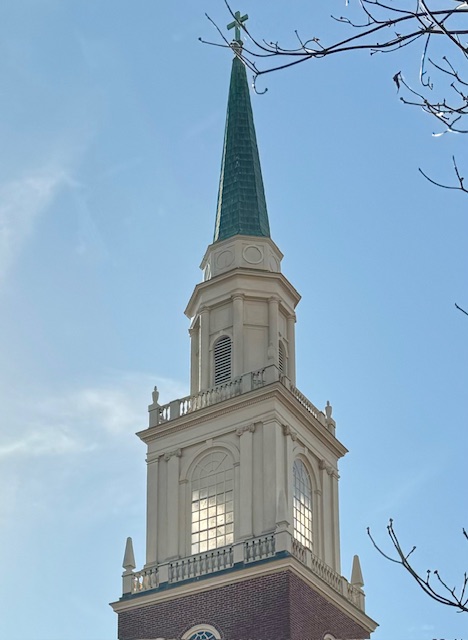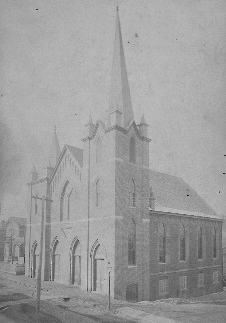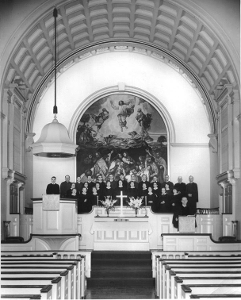Charlottesville First United Methodist Church, located at 101 East Jefferson Street, Charlottesville, Virginia, was first established in 1834 on the south side of Water Street between First and West Second Streets. We are currently in our third location. The first service in our current location was held November 12, 1925.

Included among the distinguishing features of the church sanctuary is a copy of the painting The Transfiguration. This copy was made by Mrs. Ada Payne Quarles and presented to the church on October 26, 1930. This wonderful work of art continues to enrich our worship experience to this day.
Beginnings and First Building
In 1834, Thomas Jefferson had been dead just eight years. Charlottesville was a town of about 1,500 people, largely confined to the area between First and Seventh Streets (east and west) and Water and High Streets. In this same year, the Methodists built a church on the south side of Water Street between First and West Second Streets.

1834 church
The church, built by James Lobbin, was a brick structure with a tower whose top reminded some of an upside down card table. Unfortunately the one picture we have of the church does not show the extreme top of the tower. The interior, including a balcony in the rear, seated 350, and it had an extremely high pulpit. (This may well have been the custom of the day. From the pulpit of John Wesley's City Chapel in London, the preacher could almost look eye to eye with those who sat in the balcony.) It was the general opinion in that day that musical instruments did not belong in church, so there was no organ.
Second Building
In 1859, twenty-five years after they built the first church building, the Charlottesville Methodists started building a second time.

1859, second building on Water Street
If we have some difficulty understanding why churches were not built earlier in Charlottesville, we have even greater difficulty understanding why this one was built so soon. One might suppose that they built to accommodate the growing membership, but, in fact, the church had only grown from 60 to 153 members. Membership would not approach the capacity of the church building (350) for another twenty-five years.
Charlottesville itself nearly doubled its population from 1835 to 1870 (the first year we have an actual record), but was still no more than a very small town. Church congregations have sometimes been known to move to a better site. Those early Methodists moved across the street to what is now the southwest corner of Water and West Second Streets, facing the site of their first church.
With the Rev. William E. Judkins as pastor, they started their church in 1859. The cornerstone was laid September 5, 1860, with the Widow's Son's Lodge conducting Masonic ceremonies. But they were unable to finish more than the basement, where they worshiped until 1867. Then, with the Rev. Thomas A. Ware as Pastor and G. W. Spooner, a member of the church, as builder, the upper floor was completed at a cost of $3900.00.
Twenty years later (c. 1879), the Methodists were building again. They tore off the roof and built one with a much steeper pitch, took out the windows and replaced them with better ones, shoved out the rear wall and installed their first pipe organ and a choir loft, and built a tower on each of the front comers, one topped by a high spire. Inside, they built balconies on three sides. The total result was a Gothic style church as impressive as any in the city. The work was completed in 1888 with the Rev. William E. Edmunds as pastor.
Charlottesville doubled in size from 2,600 in 1880 to 5,500 in 1890. Church membership gradually grew to 275 in 1882 and then almost doubled in five years. The first recorded Sunday School enrollment (1867) was greater than the church membership. Considering all these circumstances, the people were most likely proud of their church and community and optimistic about the future. So they remodeled the church.
They continued to raise money and gave $600.00 toward the building of a frame church erected in 1897 with 40 charter members. Thus, First Methodist Church had its first experience as the parent of a new church. In fact, between 1897 and 1898, First Methodist lost 134 members, presumably to the new church, and all the trustees were originally from the parent church. The church had a regularly assigned pastor from its beginning. Twelve years later, when it was able to be rebuilt at the corner of Hinton Avenue and Church Street, it became the Hinton Avenue Methodist Church. As for First Methodist Church, by 1900 it had practically renewed its membership from the loss in founding a new church; it had increased its budget by almost $2,000.00 (a sizable amount in those days).
University of Virginia
The University of Virginia had a great influence on Charlottesville and on the development of the Methodist Church here. The first Methodist Chaplain, 1832-34, was William Hammett, who bought, or at least acted as purchasing agent for, the lot on which the first Methodist Church was built. We can well imagine that he had considerable influence in the church. It is not surprising that, when he objected to the "legs of an upside down card table" at the top of the church tower, they were cut off.
Throughout the years of the First Church, its ministers took turns as University Chaplains.
Third (Present-day) Building

1918 church interior
In 1913 or 1914, church membership reached the 1,000 mark and Sunday School enrollment had increased to over 700. In 1916, they considered building Sunday School rooms on the rear of the old church. They hired an architect, determined the cost of the work and decided to proceed with the building. They never did! Possibly the United States' entry into World War I may have delayed the building of those Sunday School rooms.
By September of that year, they had chosen the present location; and in October, Joseph Hudnut, a New York City architect who later became a faculty member at the University of Virginia, was hired to do the planning. Ground for the building was broken on March 12, 1923.
On March 31, 1924, the Masonic Grand Lodge of Virginia joined local lodges in laying the cornerstone. At that time, the Sunday School building and the social hall were completed. A year later, the sanctuary was completed.
First Methodist Church now had a sanctuary seating 975; a social hall of the same size; a chapel seating 300; an education building that would accommodate a Sunday School when it enrolled over 1000, and a club room designed specifically for university student use. But the work was not complete. The church still owed $109,704, so it proceeded with remarkable speed to pay the debt.
In 1950, a fire, starting in the entrance to the Sunday School building, spread quickly into the chancel where it severely damaged the organ and even endangered The Transfiguration painting.

A new organ was built in 1951 by the M.P. Moller Company. While repairs were being made, the church adopted the divided chancel in preference to the original central pulpit.
Wesley Foundation at UVA
For years, First Church housed the Wesley Foundation and it met in the clubroom. In 1957 new quarters were found much nearer the campus, but as late as 1972 its director was listed on the staff of First Church. Our church continues to contribute significantly to its support; and our pastor serves on its Board of Directors.
Fostering Methodism in Charlottesville
In the First Church bulletin for December 6, 1953, we find, "The Reverend C. Warner Crumb, has been appointed to begin a new church in the west end of Charlottesville... Until the work of the new church develops to the point of having Sunday services, we extend a cordial welcome to these good friends to make themselves at home here at First Church and to call upon us for any assistance we may render them." One may well believe that First Church gave both help and encouragement, for on February 24, 1957, the congregation of Wesley Memorial Church, now self-supporting, moved into its new chapel.
Only seven years later, in 1964, Aldersgate United Methodist Church began. While First Church may not have originated the efforts on behalf of this church, we may be sure that it gave encouragement and that a number of its members and prospective members now attend Aldersgate UMC.
The Eisenhower years in the 1950's were church-going days, and First Church was a part of the nationwide trend. Church membership increased above 2,000. In 1962, youth meetings attracted over 100 each Sunday evening. Somewhere between 1950 and 1965, First Church came to a zenith; but of course, to suggest a high point is to realize that there are valleys. By the mid-60's the youth program had begun a descent. We must also remember that this was a period of youth rebellion throughout the country. Church membership dropped, and gradually, Sunday School enrollment and attendance made steeper declines.
First Church had spent the better part of a generation building and paying for its new church building. Charlottesville itself was changing. While people had gradually been moving to the outskirts of town, there was practically no shopping available on U.S. 29 North until the mid 60's - people still needed to return to downtown stores. Soon, however, with the building of shopping centers and churches (sometimes the rejuvenation of nearby rural churches) there was no need to return to the city for anything. Downtown merchants had great difficulty in surviving and churches also suffered. Charlottesville First Church actually remained strong and vigorous throughout these difficult times. Church membership dipped and wavered; but since 1975 it has remained stable at about 1500.
In 1978, the $125,000 renovation of the current Charlottesville First United Methodist Church was completed. The renovation included installing air conditioning in the sanctuary and social hall.
In 2002, First Church underwent a $2.75 million renovation of the preschool, as well as the first, second and third floors. These renovations also included the addition of a new office space, fellowship hall, welcome center, music suite, parking entrance and elevators.
In 2013, The Transfiguration painting at the front of the Sanctuary was restored by artist Stephanie Newman.
In August of 2017, Charlottesville became the center of national attention when the Unite the Right rally brought white supremacist groups to the park directly in front of Charlottesville First UMC to protest the removal of the Lee statue. Members of CFUMC, along with partner churches throughout Charlottesville, were instrumental in organizing a counter response, including the use of the CFUMC building as a place of refuge on that violent day. Members who were there on that day have shared their powerful testimonies, which you can view here.
In March of 2023, the former First UMC joined with Hinton Avenue UMC in a reunion of sorts. The newly-merged church, now known as Charlottesville First, continues to meet in the First UMC building on Jefferson Street. The congregation is helping to make the dreams of the former Hinton Avenue Church to build affordable housing for developmentally disabled adults a reality.
Charlottesville First United Methodist Church continues to be a vital part of downtown. As our history and tradition suggest, we continue to open our hearts, minds and doors in the name of Jesus Christ.
-
Details





